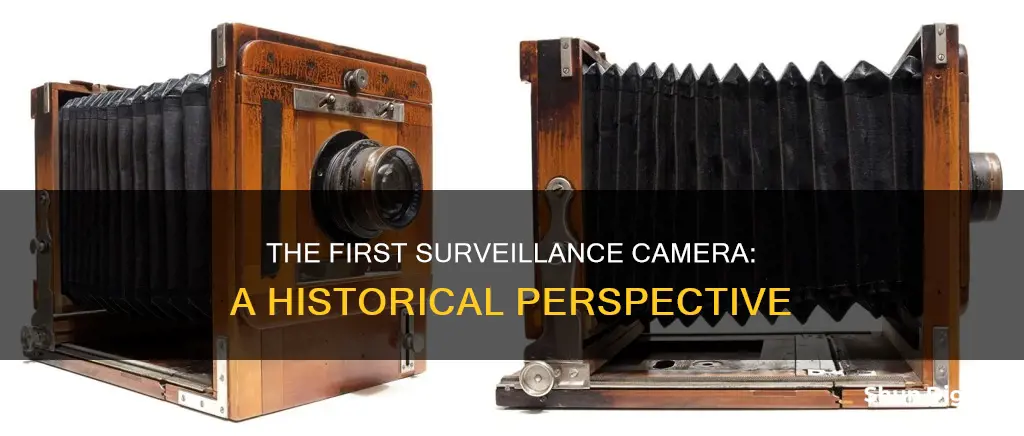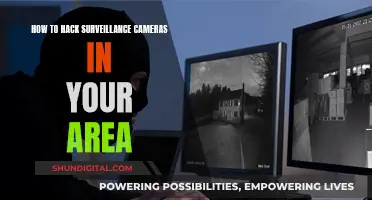
The history of surveillance cameras can be traced back to the 1920s, when Russian scientist Léon Theremin is said to have created a closed-circuit system using a camera and television. However, it wasn't until the 1940s that the first true surveillance cameras were developed. In 1942, German engineer Walter Bruch created what is considered the world's first closed-circuit television (CCTV) system, allowing Nazi scientists and military personnel to observe V-2 rocket launches from a safe distance. The first CCTV cameras available to the public appeared in 1949, produced by the American company Vericon. These early cameras required constant monitoring and could not record footage.
| Characteristics | Values |
|---|---|
| Year of first surveillance camera | 1927 (mechanical CCTV) or 1942 (CCTV) |
| Inventor of first surveillance camera | Léon Theremin (mechanical CCTV) or Walter Bruch (CCTV) |
| Country of origin | Russia (mechanical CCTV) or Germany (CCTV) |
| Purpose | To monitor visitors to the Kremlin in Moscow (mechanical CCTV) or to observe V-2 rocket launches (CCTV) |
| Commercial availability | 1949 |
What You'll Learn
- The first surveillance camera was created in the 1920s by Leon Theremin
- The first CCTV system was designed by Walter Bruch in 1942
- The first commercial CCTV system was sold in 1949 by a US company
- The first home security system was invented by Marie Van Brittan Brown in 1966
- The first IP camera was the Axis NetEye 200 in 1996

The first surveillance camera was created in the 1920s by Leon Theremin
Theremin's surveillance system was originally requested by the Soviet Council of Labour and Defence and was demonstrated to Joseph Stalin and other top Soviet officials. The system consisted of a manually operated scanning-transmitting camera and a wireless shortwave transmitter and receiver, with a resolution of 100 lines. It was subsequently installed in the courtyard of the Moscow Kremlin to monitor approaching visitors.
Theremin's invention was ahead of its time, and it would be over a decade before the next development in surveillance cameras. In 1942, an engineer named Walter Bruch designed what is considered the world's first closed-circuit television (CCTV) system. Bruch's system was used by Nazi scientists and military personnel to observe the launch of V-2 rockets.
The first publicly available CCTV system was introduced in 1949 by the US company Vericon. These early systems did not have the ability to record footage and required constant monitoring. It wasn't until the 1970s, with the advent of VCR technology, that the use of video surveillance became more widespread.
Today, surveillance cameras are ubiquitous, with over 1 billion cameras installed worldwide. Technological advancements have transformed the industry, with digital cameras, IP cameras, and AI-enhanced systems revolutionizing surveillance capabilities.
Simplisafe Camera Costs: When Do You Get Charged?
You may want to see also

The first CCTV system was designed by Walter Bruch in 1942
The first closed-circuit television (CCTV) system was designed by German electrical engineer and television pioneer Walter Bruch in 1942. Bruch's CCTV was first used to monitor V-2 rockets in Germany during World War II. This early form of video surveillance allowed operators to observe rocket tests from a safe distance.
The technology behind this innovation was groundbreaking at the time. Bruch's system consisted of cameras and monitors that enabled live video footage to be captured and streamed to screens. However, it lacked the capability to record and store footage, which would later become a pivotal feature of CCTV systems.
Following its inception, it took several years for CCTV to become commercially available. In 1949, an American company, Vericon, began selling the first publicly accessible CCTV system. This marked a turning point in the accessibility of CCTV, as it was no longer exclusively used by the military but also became a security option for businesses, banks, and private residences.
The evolution of CCTV continued with the introduction of reel-to-reel recording systems, which enabled the preservation of surveillance footage. However, these early recording methods were cumbersome and unreliable, requiring manual swapping of magnetic tapes. The arrival of video cassette recordings (VCRs) in the 1970s revolutionised the industry, making it easier to record and erase information, and leading to a wider adoption of video surveillance.
Over the ensuing decades, CCTV systems underwent significant advancements. The development of multiplexing in the 1990s allowed multiple camera signals to be synchronised and recorded onto a single tape, enhancing efficiency and popularity. The turn of the millennium brought progress in digital technology, replacing VCRs with digital video recorders (DVRs) and eliminating the need for video tapes altogether.
Today, CCTV has become an integral part of everyday life, with advanced features such as remote monitoring, wireless installations, and automatic sensors. While the initial CCTV system designed by Bruch laid the foundation, the technology has come a long way since its introduction in 1942, with ongoing innovations continuing to shape the future of surveillance.
Dummy Battery Camera: What's the Deal?
You may want to see also

The first commercial CCTV system was sold in 1949 by a US company
The first commercial closed-circuit television (CCTV) system was sold in 1949 by a US company, marking a pivotal moment in the history of security cameras. Known as "Vericon", the system was designed by CBS Laboratories and sold by Remington Rand. This early CCTV technology was advertised as not requiring a government permit since it used cabled connections between the camera and monitor, rather than wireless transmission.
The Vericon system represented a significant advancement in security control, and its introduction made security cameras more accessible to businesses, banks, and private residences, expanding their use beyond the military. Prior to this, CCTV cameras were primarily used for military purposes, such as monitoring rocket launches during World War II by the US and German militaries.
While the 1949 Vericon system marked a commercial milestone, it had limitations. Notably, it lacked the ability to record video footage, requiring constant monitoring to be effective. This challenge was later addressed in the 1960s by Marie Van Brown, who made adjustments to the existing technology, creating a CCTV system capable of recording video.
The evolution of CCTV technology continued with the introduction of digital multiplexing in the 1990s, which enabled multiple cameras to record simultaneously and improved storage capabilities. These advancements, along with the development of internet-based products and systems, have transformed CCTV into a versatile and widely adopted security solution for businesses, homes, and public spaces.
Today, CCTV systems offer a range of advanced features, including remote alerts, smart interconnectivity, and high-resolution imaging, contributing to their widespread adoption and impact on safety and security in various sectors.
Charging the Olympus SZ-14 Camera: A Step-by-Step Guide
You may want to see also

The first home security system was invented by Marie Van Brittan Brown in 1966
The history of surveillance cameras is a fascinating one, with the first CCTV camera being invented in the 1920s by Leon Theremin. However, it is important to note that the concept of home security systems was pioneered by Marie Van Brittan Brown in 1966. Here is a more detailed account of her groundbreaking invention:
Marie Van Brittan Brown, an African-American nurse from Queens, New York, faced a constant security threat in her neighbourhood due to high crime rates. The standard nine-to-five work hours of her job often meant working shifts at different times of the day, further exacerbating her sense of vulnerability. Moreover, the police response time in her area tended to be slow, which compelled Brown to seek ways to enhance her personal security.
In 1966, Brown, along with her husband, Albert Brown, an electronics technician, invented the first home security system. Their invention was an audio-visual system designed to monitor the front door and enable communication with visitors. The system consisted of multiple peepholes at different heights to accommodate people of various statures, a vertically sliding camera that could be remotely moved between peepholes, a two-way microphone, and a remote-controlled lock. The camera transmitted images to a monitor inside the house via a wireless connection, allowing Brown to see her visitors without physically going to the door.
The system also included an alarm button that, when pressed, would immediately notify the police or other relevant authorities. This feature was particularly significant for Brown, as it empowered her to take swift action in case of an emergency, addressing the issue of slow police response times in her neighbourhood.
The Browns filed for a patent for their invention on August 1, 1966, under the title "Home Security System Utilizing Television Surveillance." The patent was granted three years later, on December 2, 1969. Despite their invention not being manufactured on a large scale due to high production costs, it garnered recognition within the inventor community. Brown's home security system laid the foundation for many features of modern security systems, such as video monitoring, remote-controlled door locks, push-button alarms, instant messaging to security providers, and two-way voice communication.
Marie Van Brittan Brown's pioneering work in home security not only earned her well-deserved accolades, including an award from the National Scientists Committee, but also showcased her resilience and determination to address a pressing personal and community issue. Her invention continues to be a cornerstone of modern home security, with small businesses, single-family homes, and multi-unit dwellings utilising variations of her original design.
Camera Battery Drain: Quick Fix Tips
You may want to see also

The first IP camera was the Axis NetEye 200 in 1996
The history of surveillance cameras is a fascinating one, with the technology evolving from basic CCTV systems to the sharp-shooting, quick-responding, app-enabled devices we know today. The first surveillance camera was invented in the 1920s by Leon Theremin, but it is important to note that this was purely a CCTV camera.
The first IP camera, which marked a significant advancement in surveillance technology, was introduced in 1996. This camera, known as the Axis NetEye 200, was a groundbreaking innovation in the world of surveillance. Here are some key details about this pioneering device:
The Axis NetEye 200 was more than just a camera; it was also a web server. This meant that it could be installed as a self-contained system, requiring no additional resources or file server involvement. Users could simply connect to the camera via a web browser to capture snapshots, which could then be used for any web application or sent over the internet. This level of functionality and ease of use was unprecedented at the time.
The camera was designed to be compact and palm-sized, making it convenient for a variety of surveillance applications. Despite its small size, it packed a range of impressive features. It had a 1/4" colour CCD imager, 2.5MB of internal storage, and could record at 1 frame per second in CIF resolution or 1 frame every 17 seconds in 4CIF resolution. It also supported external storage options, such as a video tape recorder or a computer with a hard drive.
The Axis NetEye 200 was versatile and could be customised for different environments. Ulf Ridell from Informationssystem AB in Sweden designed an outdoor housing for the camera that included heating, a thermostat, a sun/rain roof, and a power supply socket. This allowed the camera to be used in a variety of weather conditions and outdoor surveillance scenarios.
The popularity of the Axis NetEye 200 grew, and it was even used to monitor the Davis Cup Finals in 1996. According to Axis co-founder Dr Martin Gren, the NetEye 200 was the first IoT (Internet of Things) device, highlighting its significance in the evolution of not only surveillance cameras but also connected devices as a whole.
In summary, the Axis NetEye 200 was a revolutionary surveillance camera that introduced the world to the capabilities of IP cameras. It combined imaging technology with web server functionality, all in a compact and versatile package. The impact of this camera extended beyond the realm of surveillance and helped pave the way for the Internet of Things, influencing the development of countless smart devices that we use today.
Charging 1080p Camera Batteries: A Step-by-Step Guide
You may want to see also
Frequently asked questions
The first surveillance camera was made in the 1920s by Leon Theremin. However, the first closed-circuit television (CCTV) system was designed in 1942 by Walter Bruch.
The first surveillance camera was large and cumbersome and required a lot of manpower to operate. It had a resolution of only 100 lines, creating a grainy and unclear picture.
Surveillance cameras became more common in the mid-20th century with advancements in digital technology and increasing concerns about crime and security. The arrival of video cassette recorders in the 1970s and the development of the first home security system in 1966 also contributed to their popularity.
The future of surveillance cameras lies in smart home security systems that use artificial intelligence (AI) and machine learning algorithms to analyze footage in real-time. These systems can detect security threats and alert authorities, enhancing safety and security.







